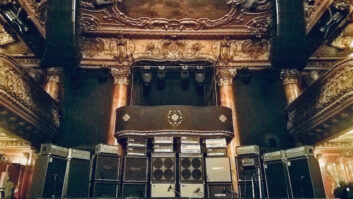
Before Gladys Knight became one of the most successful soul singers in America — fronting The Pips for a string of immortal classics, and then venturing out as a solo act — she was a jazz singer in her high school big band in her native Atlanta, learning at the knee of a man named Lloyd Terry, who in addition to being an educator, also led the top jazz group in the city. Terry’s and Knight’s career paths diverged early on, but the singer never forgot her first mentor, and three years ago, they got together to begin work on a dream project for Knight: an album of her singing songs popularized by some of the great women singers who had inspired her. Unfortunately, Terry died before the album could be made. But now we have Knight’s Before Me, which undoubtedly has Terry smiling in the Great Beyond. Produced by Grammy-winners Tommy LiPuma and Phil Ramone, it features Knight at her very best, singing songs by the likes of Ella Fitzgerald, Billie Holiday, Sarah Vaughan, Dinah Washington, Nina Simone, Lena Horne and Mahalia Jackson.
Knight stresses that the project was not an attempt to get on what she calls “the standards bandwagon” nor is it just some jazz experiment. “I wanted something from all the ladies, but more personal,” she says. “Such as, ‘Listen to these women, listen to their music, look where they’ve been and look how they’re music has survived.’ I wanted all that to come out through this music. I got a chance to meet and work with every single one of them, except Billie Holiday [who died in 1959]. They were all very encouraging and told me how proud they were of me.” (The album features standards by Duke Ellington, Count Basie, Billie Holiday and more.)
In choosing to work with LiPuma and Ramone, Knight enlisted two craftsmen with deep experience in sophisticated arrangement and recording. Then, on the musical side, she got to front an incredible band of younger and older players, including trumpeters Chris Botti and Roy Hargrove Jr., saxophonist David “Fathead” Newman, keyboardist Joe Sample, guitarists Russell Malone and Anthony Wilson, bassist/bandleader John Clayton, pianist/arranger Billy Childs and the Clayton-Hamilton Orchestra. “I walked into the studio and there they were!” exclaims Knight. “I said, ‘Oh my goodness. Is that David “Fathead” Newman, Roy Hargrove Jr.? And they’re getting ready to play on my album?’ Then I had John and Billy as the arrangers — they gave me the best of the best. I’ve never had so much love, care, attention and — royalty around me like that.” [Laughs]
Vocally, the project was a nice change of pace for Knight, who, of course, has always been known as a powerhouse — after all, she was originally recruited by Motown to be the label’s answer to Atlantic’s Aretha Franklin. “Jazz has been long associated with being cool and not over the top,” she notes. “It soothes the soul and is easy to listen to. So the performance that you do is different and I enjoyed it for that reason. I just wanted to tell the story and sing those great melodies and lyrics created by great writers.” She collaborated with LiPuma and Ramone to determine the best keys and tempos for each song.

Phil Ramone and Gladys Knight
Although LiPuma and Ramone are based in the same city (New York City) and are good friends, they worked independently with different engineers at separate studios from October to December 2005. LiPuma, with Al Schmitt engineering, chose his favorite, Capitol Records Studio A in Hollywood, renowned for being a great room for large ensemble performances. Ramone actually was slated to also work at Capitol, but Knight was touring through the East Coast at the time, so he opted to do sessions at Right Track in New York City instead, with Frank Filipetti as his recording engineer.
LiPuma notes that working on an album such as this, with timeless material and a singer who usually sings in other styles, “You really have to keep the artist in mind and the parameters you know they’re capable of doing. The most important thing is that you cast the songs correctly so they feel comfortable singing. If the artist can’t get a relationship with the song, it doesn’t matter how good it is. [For Gladys,] I think this was music that very close to her heart and songs she’s wanted to do for years.”
Ramone adds, “Her ability and sensibility of music just made it so much easier than trying to fight uphill or do something that’s not quite natural. Tommy LiPuma and I hit a path of great musicality together, even though we recorded separately. But we did listen to each other, so we didn’t suddenly have an opposite-end album. The drive of the album is Gladys; [LiPuma] took more of the big band kind of groove, while Billy Childs and I took kind of the Dinah Washington period. I like the small horn approach with nice strings added, and think more about how the rhythm worked as a group more than just a great rhythm section in the room.”
According to Schmitt, who has worked regularly with LiPuma for some 35 years and has also recorded a lot with Ramone, the setup for the sessions was very straightforward, much like a vintage recording. “She sings so well and did most of the material live, with some overdubbing, usually about two sessions a day,” he relates. “I set up the same way I used to with Rosemary Clooney [and others like her]. We try to capture that and make everyone comfortable, almost like they’re doing a live performance.
“It was recorded a little differently, however, because of the Clayton-Hamilton Big Band, who play together all the time,” Schmitt continues. “They have a lot of power, but she did, too, and kicked everyone’s butt — she can sing. It’s not a pop record or band; it’s a big swinging one and more toward jazz. On this one, we had five trumpets, four trombones, five saxophones, four in the rhythm section, and at some point there were 12 violins, six violas and four cellos. We used a lot of the vintage microphones — Telefunkens, Neumanns and on Gladys a Neumann 67. Also, I have a bunch of special preamps such as these prototypes from Upstate Audio, as well as Neve, Mastering Lab, Martech and Studer. Basically, I try to match up certain preamps with certain instruments. On the brass/trumpets, Mastering Lab; bass and piano, Studer Valve; on drums, the Neve 1073, for example.” The project was tracked to Pro Tools HD at 96 kHz, and then mixed at Capitol Studio C in January 2006 with Schmitt working on a Neve V Series desk. Everything was recorded so well that he had little problem matching the sonics of the different sessions.
Schmitt, too, was very enthusiastic about the project: “I’ve been doing this a long time and worked with probably every great singer in the world, from Barbra Streisand to Rosemary Clooney to Diana Krall. Gladys is good as they come. On top of that, she comes prepared, knows what she’s doing and is the sweetest person to work with.”
“It was glove-in-hand all the way,” Ramone remarks. “I remember one of the dates when the musicians started tapping their music stands. Billy [Childs] asked, ‘What’s that?’ ‘It’s applause man, they love what you’re doing!’ And she was the same way — it was a joyful experience.”
LiPuma adds, “It’s a pretty organic record without too many tricks. When you get down to it, there are no secrets here. You got great material, a great artist and great musicians — just get out of the way.”







